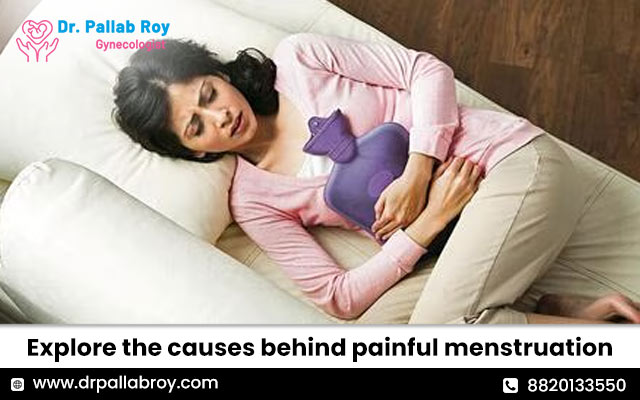For many women, menstruation is accompanied by varying degrees of discomfort, ranging from mild cramps to debilitating pain. Though some discomfort during menstruation is normal, excessive or persistent pain may be an indication of an underlying medical condition. Let’s explore the causes behind painful menstruation from the viewpoint of the best gynaecologist doctor in Behala.
Primary Dysmenorrhea
Primary dysmenorrhea is characterized by menstrual pain that is not associated with any underlying medical condition. It occurs shortly before or during menstruation and is caused by hormonal changes that trigger uterine contractions. Factors that can exacerbate primary dysmenorrhea include:
- Prostaglandins: During menstruation, the uterus produces prostaglandins, hormone-like substances that cause one’s uterine muscles to contract. Higher levels of prostaglandins can lead to stronger and more painful contractions, resulting in menstrual cramps.
- Age: Primary dysmenorrhea often begins in adolescence, shortly after menstruation starts and tends to improve with age and after childbirth.
- Lifestyle Factors: Poor diet, smoking, lack of exercise, smoking and stress can worsen menstrual pain by affecting hormone levels and blood flow.
Secondary Dysmenorrhea
Secondary dysmenorrhea is menstrual pain caused by an underlying medical condition. It typically develops later in life and may worsen over time. Common causes of secondary dysmenorrhea include:
- Endometriosis: Endometriosis refers to a condition where tissue similar to the uterus lining grows outside the uterus, often on the ovaries, fallopian tubes, or pelvic lining. The presence of endometrial tissue in these areas can result in inflammation, scarring, and severe menstrual pain.
- Adenomyosis: It occurs when the tissue lining the uterus (endometrium) grows into the muscular wall of the uterus. This can cause heavy, prolonged periods and intense pelvic pain during menstruation.
- Fibroids: Uterine fibroids refer to noncancerous growths that develop in the muscular wall of the uterus. Based on their size and location, fibroids can cause heavy menstrual bleeding, pelvic pain and pressure on surrounding organs.
- Pelvic Inflammatory Disease (PID): As per the best gynaecologist doctor in Behala, it is an infection of the female reproductive organs, mainly caused by sexually transmitted bacteria. In addition to painful periods, PID can cause abdominal pain, abnormal vaginal discharge and infertility if left untreated.
- Cervical Stenosis: It is characterized by the narrowing of the cervix, which can obstruct the flow of menstrual blood and cause intense cramping.
Other Factors
In addition to these underlying medical conditions, several other factors can contribute to painful menstruation, states the best gynaecologist doctor in South Kolkata.
- Family History: Women with a family history of painful periods may be more likely to experience menstrual pain themselves.
- Heavy Menstrual Bleeding: Excessive menstrual bleeding (menorrhagia) can increase uterine contractions and exacerbate menstrual pain.
- Psychological Factors: Stress, anxiety, and depression can amplify the perception of pain and worsen menstrual symptoms.
- Pelvic Surgery: Previous pelvic surgeries, such as a cesarean section or laparoscopic surgery, can sometimes lead to scar tissue formation and subsequent menstrual pain.
Seeking Medical Advice
In case you experience severe or persistent menstrual pain that interferes with your quality of life, it’s important to seek medical advice. Treatment may include pain relievers, hormonal therapies, lifestyle modifications or surgical interventions, based on the underlying cause and severity of symptoms. Taking the right measures and seeking timely guidance from the top gynaecologist doctor in Behala can help address the underlying cause of painful menstruation can help improve your menstrual health and well-being.

